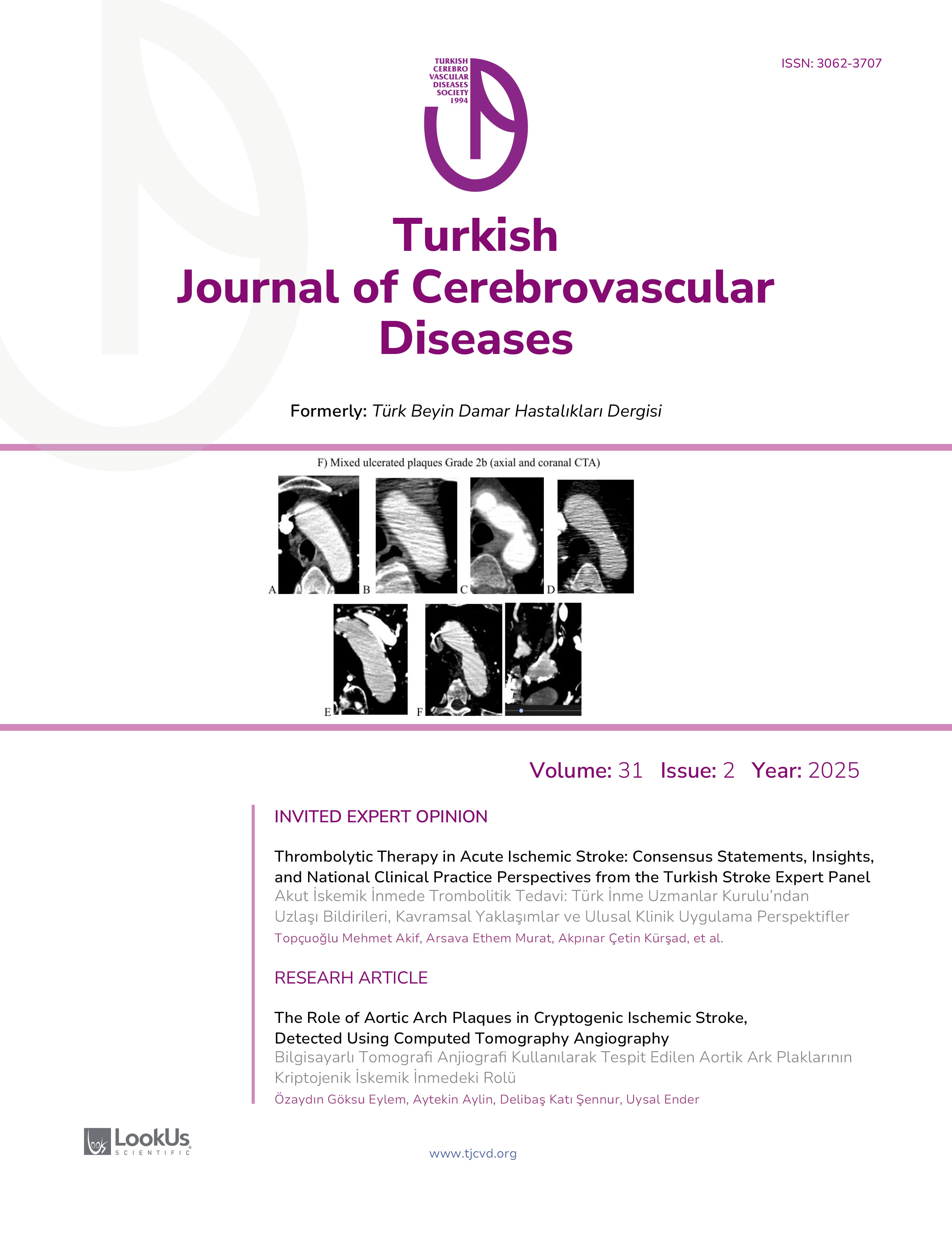Factors Determining Prognosis in Patients Undergoing Thrombectomy for Basilar Artery Occlusion
Muttalip Özbek1, Cumali Çetiner2, Hamza Gültekin2, Esref Akıl21Department of Neurology, Mardin Kızıltepe State Hospital, Mardin, Türkiye2Department of Neurology, Faculty of Medicine, Dicle University, Diyarbakır, Türkiye
INTRODUCTION: Background: In this study, we aimed to investigate the factors that may affect the prognosis of patients who underwent endovascular treatment for basilar artery occlusion (BAO).
METHODS: The data of patients admitted to the Dicle University Stroke Center between January 1, 2019, and April 1, 2024, were retrospectively analyzed. Patients with conditions that could affect prognosis, such as prior sequelae, malignancy, or receiving thrombolytic therapy before endovascular treatment, were excluded. A total of 38 patients met the inclusion criteria. The patients' admission and 24-hour post-procedure National Health Stroke Scale score (NIHSS), admission Glascow Coma Scale (GCS) score, basilar artery occlusion segments, Thrombolysis in Cerebral Infarction (TICI) recanalization score, 3-month modified Rankin score (mRS), and the number of PASS attempts performed for recanalization were evaluated. Additionally, preoperative lymphocyte, hematocrit, neutrophil counts, and neutrophil-to-lymphocyte ratios (NLR) were calculated. The relationships between these factors and prognosis and mortality were analyzed.
RESULTS: In our study, which retrospectively evaluated a total of 38 patients, the factors statistically significantly associated with functional independence (mRS 03) at the 3-month mRS score were the admission NIHSS score, the 24-hour NIHSS score, and the number of PASS attempts performed for recanalization (P=.005, P<.001, and P=.048, respectively). mRS scores of 46 were considered functionally dependent. Based on the results of the ROC and multivariable logistic regression analyses, the preoperative NLR value appears to be an independent predictor of mortality (AUC: 0.898, P=.029, 95% CI=1.064-3.434). In both ROC and regression analyses, lymphocyte levels were not associated with mortality.
DISCUSSION AND CONCLUSION: Although the number of patients in our study is limited, our results are consistent with many studies on EVT performed for BAO. Additionally, we believe that identifying the relationship between preoperative NLR and mortality is valuable. In this context, we hope that our study can shed new light on the pathophysiology of ischemic stroke and the evaluation of patient prognosis after EVT.
Baziler Arter Oklüzyonu Nedeniyle Trombektomi Uygulanan Hastalarda Prognozu Belirleyen Faktörler
Muttalip Özbek1, Cumali Çetiner2, Hamza Gültekin2, Esref Akıl21Mardin Kızıltepe Devlet Hastanesi, Nöroloji Kliniği, Mardin, Türki̇ye2Dicle Üniversitesi Tıp Fakültesi, Nöroloji Anabilim Dalı, Diyarbakır, Türki̇ye
GİRİŞ ve AMAÇ: Amaç: Bu çalışmada, baziler arter oklüzyonu (BAO) nedeniyle trombektomi uygulanan hastaların prognozunu etkileyebilecek faktörleri araştırmayı amaçladık.
YÖNTEM ve GEREÇLER: 1 Ocak 2019 ile 1 Nisan 2024 tarihleri arasında Dicle Üniversitesi Tıp Fakültesi İnme Merkezine başvuran hastaların verileri retrospektif olarak analiz edildi. Eski sekel, malignite öyküsü veya endovasküler tedaviden önce trombolitik tedavi almış olmak gibi prognozu etkileyebilecek durumlara sahip hastalar çalışma dışı bırakıldı. Toplam 38 hasta dahil etme kriterlerini karşıladı. Hastaların kabul ve işlemden 24 saat sonra Ulusal Sağlık İnme Ölçeği (NIHSS) skoru, kabul Glasgow Koma Ölçeği (GCS) skoru, baziler arter oklüzyon segmentleri, Serebral Enfarkt Tromboliz (TICI) rekanalizasyon skoru, 3 aylık modifiye Rankin skoru (mRS) ve rekanalizasyon için gerçekleştirilen PASS girişimi sayısı değerlendirildi. Ayrıca, ameliyat öncesi lenfosit, hematokrit, nötrofil sayıları ve nötrofil-lenfosit oranları (NLR) hesaplandı. Bu faktörler ile prognoz ve mortalite arasındaki ilişkiler analiz edildi.
BULGULAR: Toplam 38 hastanın retrospektif olarak değerlendirildiği çalışmamızda, 3. ay mRS skorunda fonksiyonel bağımsızlık (mRS 0-3) ile istatistiksel olarak anlamlı ilişkili faktörler; yatış NIHSS skoru, 24 saatlik NIHSS skoru ve rekanalizasyon için gerçekleştirilen PASS girişimi sayısıydı (sırasıyla P=.005, P<.001 ve P=.048). 4-6 arasındaki mRS skorları fonksiyonel olarak bağımlı kabul edildi. ROC ve çok değişkenli lojistik regresyon analizlerinin sonuçlarına göre, preoperatif NLR değeri mortalitenin bağımsız bir öngörücüsü gibi görünmektedir (AUC: 0,898, P=.029, %95 CI=1,064-3,434). Hem ROC hem de regresyon analizlerinde lenfosit düzeyleri mortalite ile ilişkili bulunmadı.
TARTIŞMA ve SONUÇ: Çalışmamızdaki hasta sayısı sınırlı olsa da, sonuçlarımız BAO için yapılan birçok EVT çalışmasıyla tutarlıdır. Ayrıca, ameliyat öncesi NLR ile mortalite arasındaki ilişkinin belirlenmesinin değerli olduğuna inanıyoruz. Bu bağlamda, çalışmamızın iskemik inmenin patofizyolojisine ve EVT sonrası hasta prognozunun değerlendirilmesine yeni bir ışık tutabileceğini umuyoruz.
Manuscript Language: English








